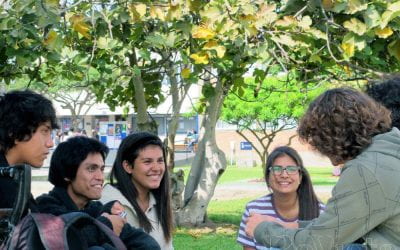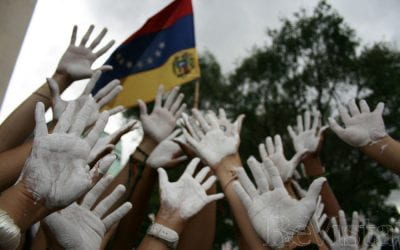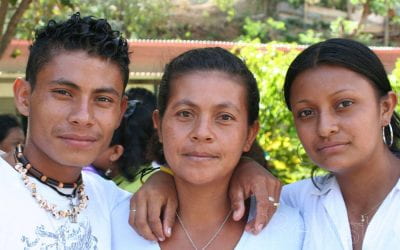Student Activism
Utopian Dreams

Students lie down in a protest in Mexico. Massive student demonstrations have a long history in Latin America. Photo by Jaime Pensado.
“Democracy, here? That is a joke!” remarked Veronica, one of the thousands of “rechazados” who failed to be admitted to Latin America’s largest public university (UNAM) and leading representative of the “Yo Soy 132 Movement.” For this 19–year old student, who preferred her last name not to be used, Mexico has simply “ceased to exist” as a nation. What Mexico and the rest of the continent need to guarantee some sense of economic and political independence, she affirms with passion, “is a spiritual revolution led by our youth. We must unite to destroy the neoliberal structure once and for all! Call me utopian, but I just don’t see another solution to our otherwise bleak Latin American reality.”
Many might indeed dismiss Veronica’s dreams as simply “utopian,” as she, herself, reluctantly suggests. But Veronica is not alone. Today thousands of students from all over Latin America are protesting for different motives, and like Veronica, they too are calling for continental unity with young students at the vanguard. The most militant young activists in Chile, Venezuela, Argentina, Bolivia, Puerto Rico, Mexico, Colombia and Brazil are demanding deep structural changes to radically transform the societies in which they live. Others are protesting to obtain specific university reforms, and aware of the rich history of student activism in Latin America, they are demanding respect for academic freedom, democracy and university life.
Scholars have traced the first student uprisings to the 17th century, but a championing of youth as active agents of political and social change is a fairly recent phenomenon. Ricardo Flores Magón, Jose Vasconcelos, Julio Mella, Raul Haya de la Torre, Fidel Castro, Che Guevara, Carlos Fonseca, José Mujica, and Dilma Rousseff (among many others) initiated their “revolutionary dreams” as young student activists, and once in power, they all recognized the importance of youth in their distinct visions of the Americas. Every single decade of the 20th century, in fact, has witnessed a significant student uprising and all of the most influential parties in Latin America have tried to co-opt and/or negotiate with disgruntled student activists by creating their respective youth wings. In particular, there have been three key moments when Latin American students shook up the status quo and in so doing assumed the role of key protagonists in history: the 1920s, the more turbulent 1960s, and more recently, the anti-neoliberal 1990s-2000s.
I. 1890s-1920s
“The youth you are now living is a form of power; it is you who must employ it.”—José Enrique Rodó
As positivism, or the application of scientific management to direct human progress, began to show signs of decadence at the turn of the 20th century, youth captured the attention of influential intellectuals across Latin America. The Uruguayan José Enrique Rodó emerged as the most influential of these writers as a result of his famous essay, “Ariel” (1900) in which he celebrated youth as a “heroic idea” and as the “promising future” of the Hispanic continent. He called upon young universitarios, in particular, to assume more active roles as “missionaries” and “philanthropists.” Echoing Rodó’s words and in direct response to the Spanish-American War of 1898, the Argentine writer Manuel Ugarte also saw youth as a promising collective identity capable of taking a more critical stance against the physical and spiritual invasions of the imperialist North. José Vasconcelos and Pedro Henríquez Ureña expressed similar sentiments in Mexico and Central America. For these young arielistas (who embraced “Ariel” as a political manifesto), the idealized future depicted by Rodó required the rejection of the “cannibalistic dogmas” of positivism in favor of the “Christian values” and “beauty” that the Hispanic continent shared. In particular, they encouraged their fellow students to shun the materialistic aspects of the North, the detrimental consequences of Social Darwinism, and the fetishism of positivist science, which they saw as engrained in the Latin American educational system.
The language of social justice and independence that characterized the Mexican and Bolshevik revolutions (1920-1917) further spurred young Latin Americans to envision a new era of great hope. In contrast, for an increasing number of university students the culmination of World War I awakened a new feeling of unprecedented doubt in Western civilization. Similarly, for many students and rising intellectuals, the 1929 economic depression signaled the “inevitable demise” of capitalism.
In this ambivalent environment of despair and great hope, the Argentine writer José Ingenieros encouraged young Latin Americans to accept social responsibility and embrace a stronger sense of nationalism and hemispheric solidarity. But first, he warned students, it was crucial to reform the archaic institution of the university, which had failed to adapt to the new Latin American reality. In agreement with rising intellectuals in Mexico, Peru, Chile and Uruguay, he argued “the university ought to be a school of social and political action.” Together, they called for a democratization of Latin American universities and argued that the control of these institutions needed to be wrested away from the elites so that higher education would be available to all who could benefit from it, regardless of their social or economic standing.
It did not take long for Ingenieros’ words to be heeded by Latin America’s most politicized students. In 1918, a group of Argentine universitarios launched their famous Córdoba manifesto. Here, the young reformistas demanded full university autonomy, greater academic freedom, broad-based university reform, and the creation of representative student organizations on faculty councils, which they viewed as corrupt and authoritarian. In contrast, the reformists argued, “youth” was surrounded by “heroism.” It was “disinterested” and “pure,” and by definition was the rightful creator of the modern educational institution.
After a series of massive student strikes and negotiations with Argentina’s president, the young reformists won a number of important victories that would impact student lives of throughout the continent. The most important of these included university autonomy and the creation of co-gobiernos (equal division of power among students, faculty, and alumni) inside the universities. Similar student strikes soon followed in Uruguay, Cuba, Venezuela, Chile, Peru, Mexico and Colombia, where the concept of university autonomy was further redefined to meet their unique academic
interests. Simultaneously, Latin American university students organized numerous international conferences, gave public speeches, founded the first student societies, expressed the need to create solidarity networks with the working class, founded “popular universities,” and put out publications characterized by a more continental outlook and concern for the political and socioeconomic problems of their respective societies. Here, the students also came to see youth as a positive collective identity. They were introduced to and reacquainted with a wide range of old and new ideologies, such as Marxism, anarcho-syndicalism, and Christian Democracy and many became key participants in the creation of new communist, socialist, nationalist, and conservative parties.
Moreover, in these new spaces students were able to debate what they perceived to be the most pertinent national and international issues. These varied tremendously in content, from the use of natural resources and agrarian problems to specific questions about the possibility of creating political alliances with the working class. Of particular importance was the role young universitarios should play in bringing about a more equitable future for all Latin Americans based on economic and political justice. However, the national issues that appeared to have generated the greatest debates during the student congresses were education and presidential elections. Despite the deep distrust that students expressed regarding older authorities throughout this period, Latin American universitarios continued to see their respective governments as the supreme authority for guaranteeing social and economic progress.
A variety of international issues and events also captured the attention of universitarios at the student congresses. The specific themes varied from presentation to presentation, but the majority usually shared a common factor: a deep distrust of “imperialismo yanqui.” In particular, students expressed great concern over “dollar diplomacy” and overwhelmingly opposed the financial privileges enjoyed by North American entrepreneurs with regard to Latin America’s natural resources. In addition, university students expressed great dissatisfaction with the U.S military presence in Cuba, Puerto Rico, Nicaragua and the Dominican Republic; they were particularly outraged by the increasing influence the U.S. government wielded with regard to the internal affairs of those countries.
In sum, universitarios of the 1920s were able to portray themselves as a responsible “student class” worthy of social and political rights. As reflective of their elitist upbringing, they saw education as a panacea to Latin America’s most detrimental problems, and influenced by a series of international events and key figures such as Martí, Rodó, Darío, Zapata and Sandino, they led the first important wave of student activism that guaranteed university autonomy throughout the Spanish Americas.
II. The 1960s
The 1960s saw the emergence of a distinct spirit of revolution and reactionary violence. From this tension emerged an innovative sense of “liberation” primarily epitomized by the Cuban Revolution and the emergence of new iconic leaders, including Fidel Castro, Che Guevara, Mao Tse Tung, Patricio Lumumba, Herbert Marcuse, and Camilo Torres. For universitarios, the term liberation became the key words of the day. Linked to the arielista awareness of international solidarity, the term served as part of an innovative language of dissent used to articulate with urgency the students’ opposition to capitalism, imperialism, and reformism. But liberation meant something broadly cultural as well; it allowed them to construct a collective identity that opened the possibility for alternative lifestyles and new countercultural spaces of expression.
Student manifestoes, bulletins, and newspapers, as well as films, comics, and academic journals produced and consumed at the various universities influenced the explosion of new student organizations and the revaluation of the importance of ideology. Students demanded the improvement of school facilities, but more significantly, they defended the autonomous status of their universities, redefined the importance of Marxism, discussed the multiple meanings of the Cuban Revolution, participated in the rising feminist movement, and challenged what they saw as the “traditional” values and norms of the status quo. On the other hand, the new student culture that emerged in the 1960s also factionalized the university. It introduced new forms of student violence that students welcomed to compete with the police and other “reactionary” forces that came in defense of the “status quo.”
As in other parts of the world, the tensions took place in the forms of street barricades, guerrilla theater, and polarizing asambleas that peaked in both numbers and intensity during 1968. The most violent of these clashes took place in the Plaza of Tlatelolco in Mexico City, where more than three hundred students lost theirs lives. But violent clashes between the police and the students also took place in the streets of Bogotá, Sao Paolo, Buenos Aires, Guatemala, Quito and Lima. In each of these places, students not only celebrated the Cuban Revolution, but also demanded an end to the rising military dictatorships in the Southern Cone, embraced the teachings of Liberation Theology, protested against the brutal War in Vietnam, condemned the U.S. and Soviet involvement in the Third World; and in so doing, they influenced other youthful uprisings in Europe and the United States. They played protagonist roles in the rising sexual revolution and the global counterculture. They joined distinct guerrilla movements and participated in various artistic movements to break the chains of colonialism, exposed the growing economic and political gap between the few in power and the overwhelming impoverished majority, and pressured the hierarchy of the Catholic Church to take a more active role in minimizing such gap.
III. The 1990s-2000s
Marginalized sectors of Latin America have been at the forefront of massive uprisings against neoliberalism: “el caracazo” of 1989 in Venezuela, the Zapatista rebellion of 1994 in Chiapas in southern Mexico, the Cochabamba water wars of 2000 in Bolivia, and the “saqueo” riots of 2001 in Argentina. Unlike previous revolts, these were distinguished by their participatory democracy and “horizontalism.” In each of these cases, marginalized communities and disenfranchised workers self-organized from below and rejected what they saw as the historical vanguardist approach of the left. Moreover, in each of these cases, the Internet played an important role in providing a means for the rapid dissemination of information that was otherwise ignored and/or distorted in the mass media.
For Latin American students the neoliberal project has meant steady increases in tuitions. The threat of privatization has transformed secondary and higher education from a historical right into a market commodity. Nonetheless, influenced by the horizontalism of the popular uprisings of the 1990s, students have launched a number of massive revolts that have prevented a complete privatization of their schools. The first of these massive strikes took place in 1999, when Mexican students took possession of the UNAM campus and nearly paralyzed the educational system for more than nine months. Soon, others would follow: Chile in 2006 and 2011; Colombia and Puerto Rico in 2011; and Mexico, again, in 2012. As Veronica explains, “we are tired of receiving a second rate education. The educational system in Mexico has produced one of the most unequal societies in Latin America.” Indeed, the level of poverty continues to increase yet social expenditure on education and other social programs continue to be reduced, as dictated by the International Monetary Fund (IMF) and the World Bank. “As students,” she continues, “We must learn from our rich history of student activism and regain control of our destiny. The entire educational system must be changed radically so that we, ourselves, can make it more inclusive and democratic. The same is true of the means of communication, the agricultural and labor sectors, and the health care system. Students throughout Latin America are sick and tired of engaging in useless negotiations with our governments. Like the Zapatistas, we say ‘basta.’ Enough is enough! We will continue to take over the streets and schools of Mexico City, Buenos Aires, San Juan, Lima, Santiago, and Sao Paulo until our respective governments guarantee us a better future, no longer with empty rhetoric and antiquated leftist promises, but with concrete policies and actions.”
The student mobilizations that are taking place in Caracas and La Paz further demonstrate that the activism of today is not ideological. Latin American universitarios have demonstrated that they are willing to pressure leftist and conservative governments, alike. This latest wave of student activism has, in fact, distinguished itself for its pragmatism and conscious rejection of all forms of authorities and ideologies, as Veronica and other members of the Yo Soy 132 Movement suggest. Like the arielista generation of the 1920s and the more militant activists of the 1960s, they too have called for greater continental solidarity.
Twitter, Facebook, and YouTube have replaced the conferences of the 1920s and student newspapers of the 1960s. Images of Che Guevara are still waved during student marches. Yet, Marxism and other orthodox leftist ideologies seem to have lost resonance. Instead, this latest generation of Latin American activists have complemented their struggles to end the inequality of the educational system with a variety of new flags, including the rainbow flag for same sex marriage. “Respect for all human rights, Veronica concludes, “has become our central priority. Utopian dreams for a better Latin American reality will continue to be expressed in the streets until those in key positions of power start taking us seriously and begin listening to our demands.”
Fall 2012, Volume XII, Number 1
Jaime Pensado is an Assistant Professor of History at Notre Dame. He received his Ph.D. from the University of Chicago.
Related Articles
University Lessons: Editor’s Letter
I learned about universities on the barricades. Well, not exactly. I was a philosophy student at Barnard—the women’s college at Columbia University—when the uprising began in 1968. Students, including my boyfriend and several classmates, took over buildings to protest…
The Last Word
More than twice as many Latin Americans are attending institutions of higher education than two decades ago, and the number will continue to increase as more students graduate from secondary schools. ReVista’s timely focus on higher education is thought-provoking…
Making a Difference: A Problem With the UN Millennium Goals
Every Saturday for two years, Estevana Sánchez walked through the jungle for miles, in the dark, crossing a river in the rainy season, to finish high school. Her five teenage children did the same. At the end of the trail, they took a long bus ride to the town of San Juan del Sur…




